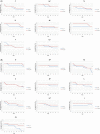Preservation of red blood cell antigenicity in a new storage solution in vitro
- PMID: 36519679
- PMCID: PMC9762792
- DOI: 10.1080/07853890.2022.2157476
Preservation of red blood cell antigenicity in a new storage solution in vitro
Abstract
Introduction: Red blood cell (RBC) storage solution is used for suspending and preserving RBCs for later use in in vitro immunohematology testing. Proper RBC preservation is crucial for obtaining accurate results in RBC phenotyping and pretransfusion antibody screening tests. Haemolysis or RBC antigen degradation during storage can result in inaccurate RBC phenotyping, thereby decreasing the sensitivity of pretransfusion antibody screening and identification assays. The conventional RBC storage solutions usually contain adenosine, adenine, and antibiotics. We designed an RBC storage solution and determined whether it could preserve RBC integrity for 70 days.
Materials and methods: The new storage solution has a different formula from that of the conventional solution-in particular, it is strengthened with polyethylene glycol (PEG). The extent of haemolysis and hemagglutination reactivity of the RBC antigen systems, Rh, Duffy, Kidd, Lewis, MNS, P1, and the rare antigen Mia (which has a low prevalence antigen in most parts of the world but a higher prevalence in Taiwan), in the new RBC storage solution was compared with that of the conventionally preserved RBC storage solution.
Results: The RBCs preserved in the new solution for 70 days retained a similar haemolysis grade as those preserved in the control solution for 28 days. Although both solutions largely preserved RBC antigenicity, the decline in RBC hemagglutination scores in new solution often occurred later than that in the control solution in most antigen phenotyping assays, especially labile antigens such as D, P1, and M.
Conclusion: The new solution reduces haemolysis more effectively and preserves antigenicity throughout the 70-day storage period. Moreover, Mia antigen is more stable in the experimental group.
Keywords: RBC antigenicity; haemolysis; modified RBC preservation (storage) solution; polyethylene glycol (PEG).
Conflict of interest statement
No potential conflict of interest was reported by the author(s).
Figures



References
-
- Chin-Yee I, Arya N, d‘Almeida MS.. The red cell storage lesion and its implication for transfusion. Transfus Sci. 1997;18(3):447–458. Available from: https://www.sciencedirect.com/science/article/pii/S095538869700043X. - PubMed
-
- Lippi G, Blanckaert N, Bonini P, et al. Haemolysis: an overview of the leading cause of unsuitable specimens in clinical laboratories. Clin Chem Lab Med. 2008;46(6):764–772. Available from: https://www.degruyter.com/view/journals/cclm/46/6/article-p764.xml. - PubMed
-
- Kucherenko YV, Bernhardt I.. Natural antioxidants improve red blood cell “survival” in non-leukoreduced blood samples. Cell Physiol Biochem. 2015;35(5):2055–2068. - PubMed
-
- Wiseman GM. The hemolysins of Staphylococcus aureus. Bacteriol Rev. 1975;39(4):317–344. Available from: https://pubmed.ncbi.nlm.nih.gov/1108866. - PMC - PubMed
Publication types
MeSH terms
Substances
LinkOut - more resources
Full Text Sources
